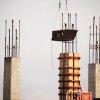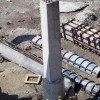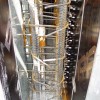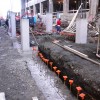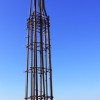Concrete Piles
Video
alt="" Offshore Pile DrivingConcrete piles are a type of building foundation system often designed and specified when the sub-grade soils required to support a structure are located too deep below the project’s grade elevation for less expensive foundation designs to be considered. The final tip elevation of concrete pile foundations are generally installed many times deeper than the bottoms of traditional concrete footings. Piles of all material construction, lengths and cross-sections are considered either to be friction piles or end-bearing piles. Friction piles, as their name implies, get most of their support strength through the frictional force that develops between the surface area of each pile face and the sub-grade soils that the pile is placed in.
Concrete piles may be either cast-in-place or pre-cast. Cast-in-place concrete piles may be installed as either cased or uncased piles. With cased cast-in-place piles, concrete is placed within a metal casing or pipe that remains in the ground and has been previously driven or installed to the proper final tip elevation. Uncased cast-in-place piles employ a similar technique, except that the sub-grade soils serve as the formwork in an open hole of the proper dimensions which has previously been drilled to the proper final tip elevation. Precast concrete piles arrive at the project site fully cured, and are then typically driven to their required depth with a pile hammer. Pre-cast concrete piles are usually reinforced with reinforcing steel and may also be pre-stressed to account for any anticipated structural loads during placement or their service life.
See also: Driven Piles vs. Jetted Piles - A Comparison

Buildipedia Staff
The Buildipedia research and writing staff consists of dozens of experienced professionals from many sectors of the industry, including architects, designers, contractors, and engineers.
Website: buildipedia.com/

